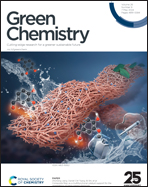Poly(ionic liquid)s: an emerging platform for green chemistry
Abstract
Recently, poly(ionic liquid)s (PILs) have emerged as a family of polymeric materials which are being increasingly investigated for interdisciplinary applications. Their high electrical conductivity, excellent thermal/mechanical stability, low vapor pressure, and easy processibility render PILs exceptionally attractive as versatile platforms for green chemistry. Recent decades have witnessed fruitful efforts devoted to the development of PIL-based green chemistry platforms, achieving significant discoveries that will unfold their uniqueness in catalysis, separation, sensors, electrolyte, and functional materials. However, few review papers offer comprehensive discussion on PILs’ application in the green chemistry field. In this review, we initially introduce the structure and types of PILs, which is followed by a systematical summary of the synthesis of PILs in terms of direct polymerization of monomer, polymerization after monomer modification, and modification of polymers. Furthermore, several aspects of the application of PILs related to green chemistry are highlighted, such as sensors, separation, catalysis, electrolytes for energy storage devices, and as versatile precursors yielding functional materials. Current challenges and corresponding research directions in PILs for green chemistry are clarified, to make PILs truly green platforms for existing technologies.

- This article is part of the themed collection: 2024 Green Chemistry Reviews


 Please wait while we load your content...
Please wait while we load your content...